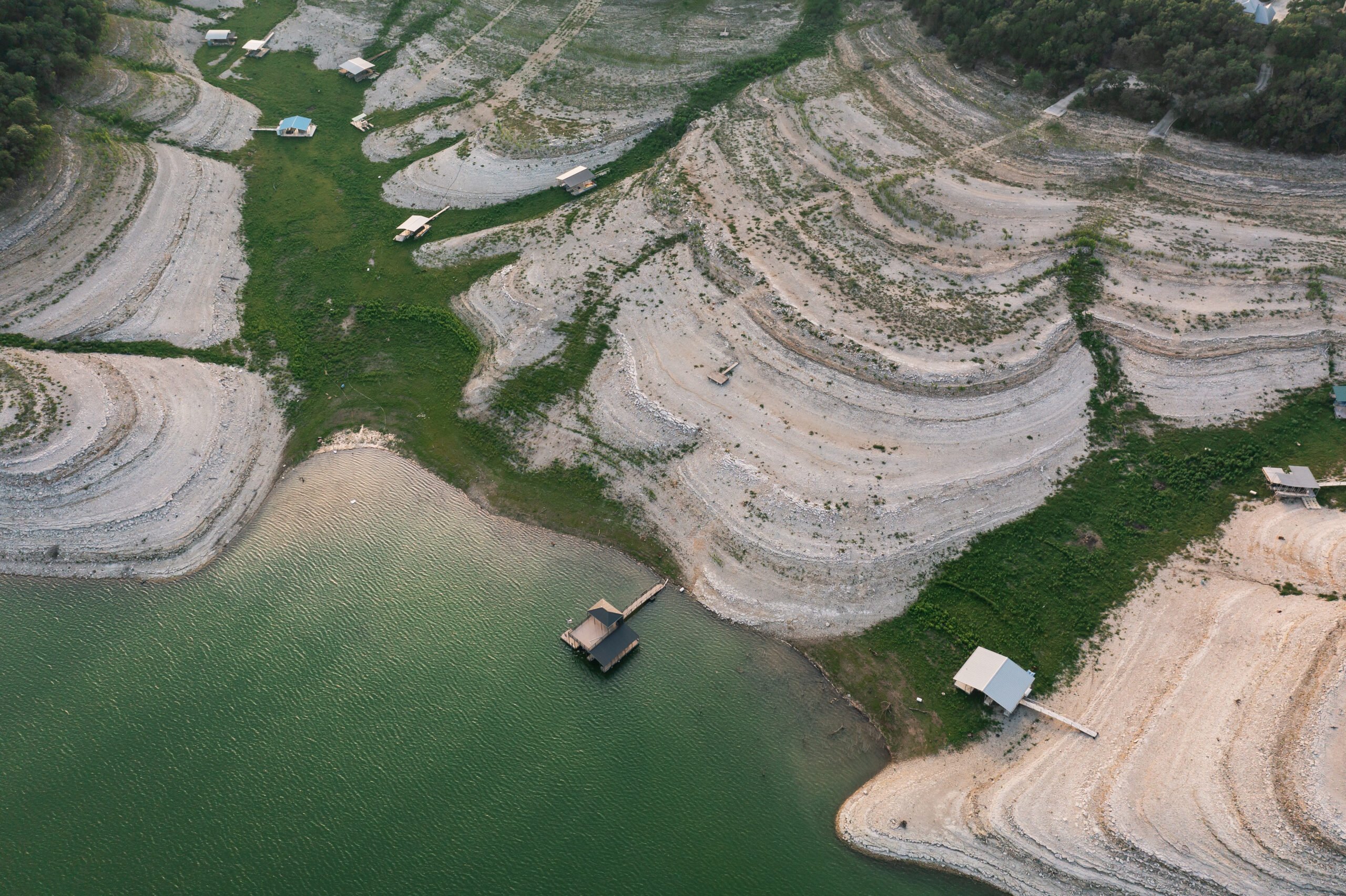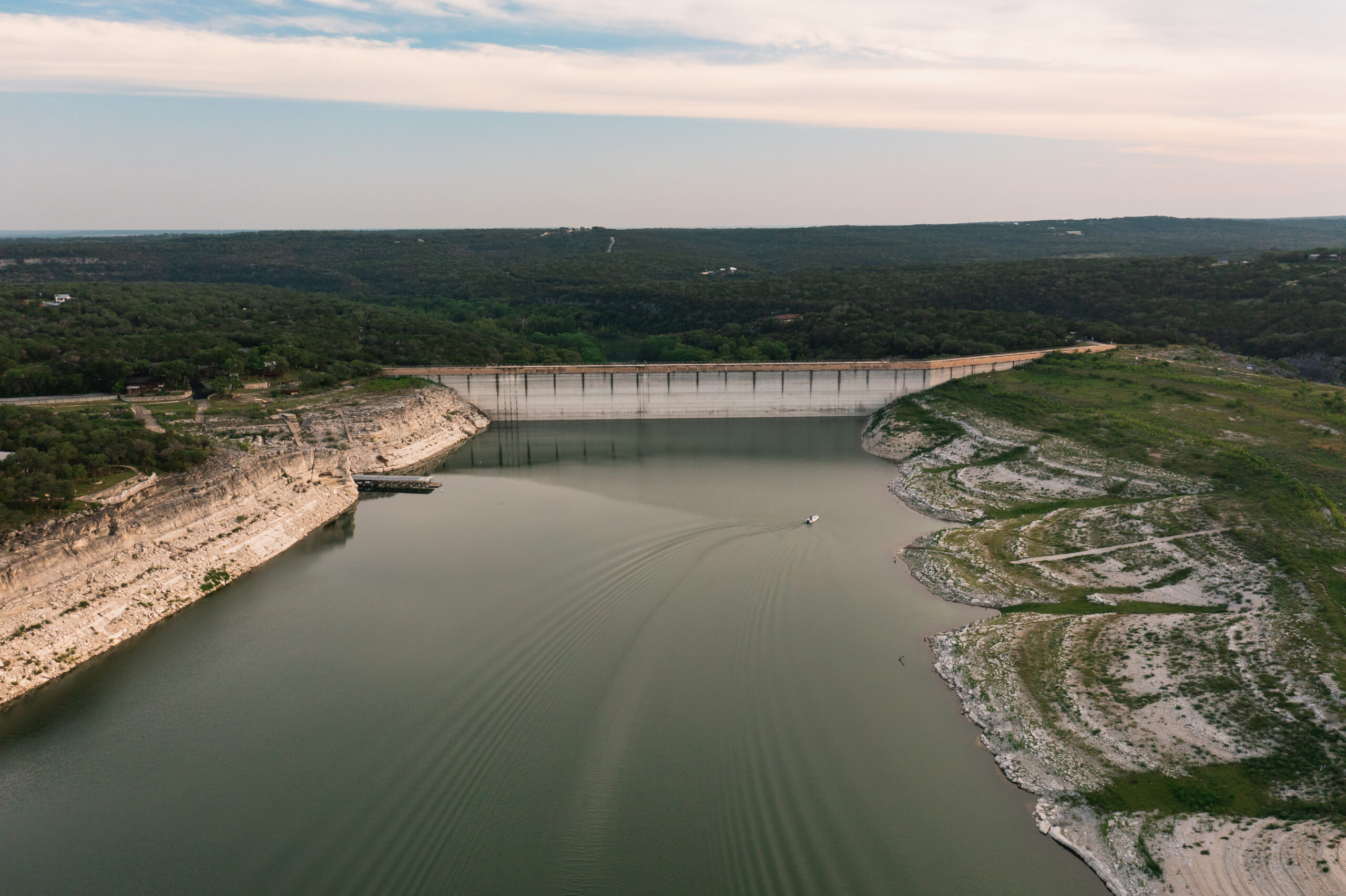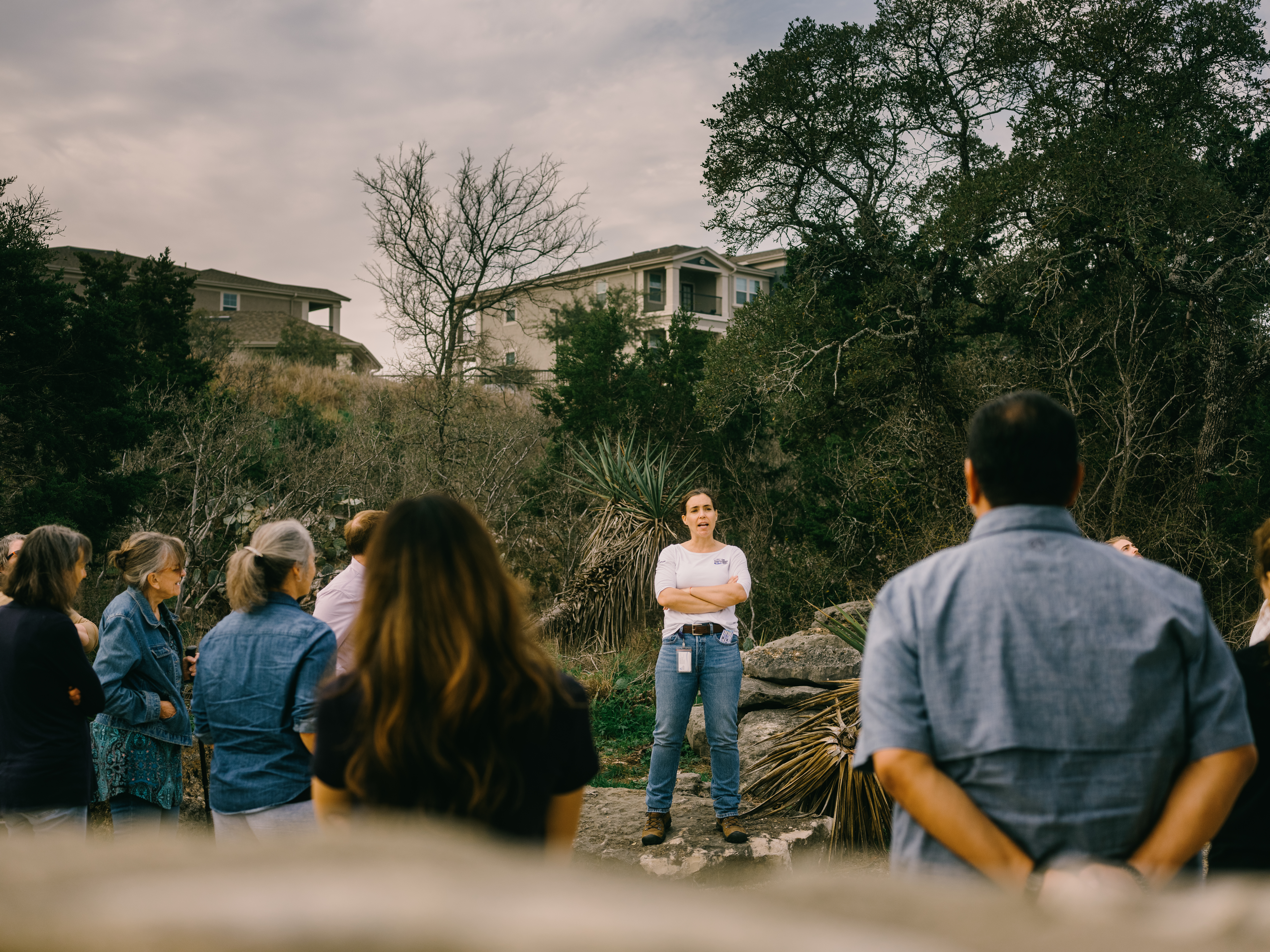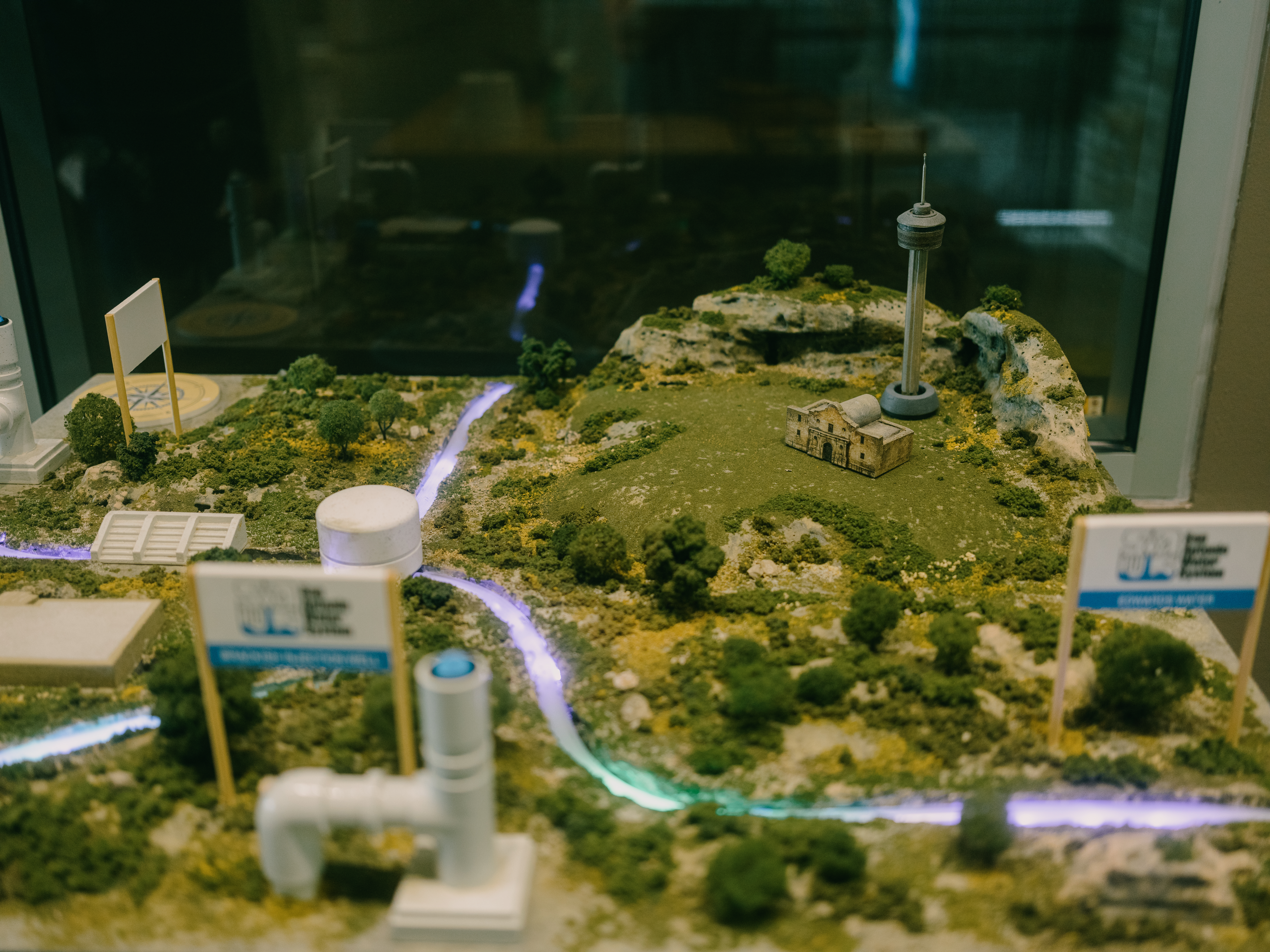
This is Part 4 of Drifting Toward Disaster, a Texas Observer series about life-changing challenges facing Texans and their rivers. For part 1, see “The Second Rio Grande“; part 2, see “Breaking the Brazos“; and part 3, see “Dow’s River.”
During busy summer days, more than 200 recreational boats launch from Red Cove Cafe & Marina in the unincorporated community of Mico. But on a Wednesday morning this May, only two boaters’ cars sat in the parking lot on the shore of Medina Lake. Chance Heyen, the young proprietor, said his family closed their cafe in 2021 because of the lake’s dropping water levels and dwindling numbers of tourists.
Given Mico’s tiny population, “We pretty much rely on traffic coming from out of town,” Heyen said.
Medina Lake stretches for 18 miles, forming a skinny dragon shape between Medina and Bandera counties. It was built in 1912 by damming the Medina River to create an irrigation reservoir for farmers. Mico, less than an hour’s drive west from San Antonio, was originally named after the Medina Irrigation Company and then morphed into a seasonal vacation destination. To thrive over the decades, the family-run marina and cafe has had to adapt to a boom-and-bust water and tourism cycle.
Right now, the community is stuck in a deep bust. This sliver of Texas on the edge of the Hill Country has been the epicenter of an intense statewide drought that began in fall 2021 and has never fully broken. At the beginning of May, Medina Lake was only 5 percent full. Most of the reservoir’s 164-foot dam was exposed, and many homes’ private docks sat stranded on dry land.
Heyen said his family has come to expect dry years, and hopes to reopen Red Cove Cafe whenever the water level rises again.
But not even local farmers depend on this reservoir as a reliable water supply anymore. In fact, Medina Lake is one of the places where the state’s water woes are most glaringly visible.
The reservoir is owned and operated by the Bexar-Medina-Atascosa Water Control and Improvement District. During a visit to the water district’s office this May, printer paper signs declaring “Stage 4” drought were taped to the customer service windows. Board members had instructed staff not to speak to the press. Instead, office manager Bonnie Tapp Sallee handed the Texas Observer a copy of a letter sent to the district’s 2,200 customers—mostly farm owners—in October, announcing a temporary halt to water sales. The moratorium is still in effect.

The City of San Antonio used to draw some of its water from Medina Lake, but hasn’t done so since 2015 because of the reservoir level’s dramatic ups and downs.
Ironically, Texas officials’ proposed methods of securing water for the state’s growing population rely heavily on reservoirs, despite challenges posed by climate change, along with other major infrastructure and technology investments.
Texas’ 2022 State Water Plan, published every five years by the Texas Water Development Board (TWDB), calls for building more than 20 new major water supply reservoirs. According to the plan, statewide demand for water is expected to grow by 9 percent between now and 2070, mostly due to growing cities. Texas’ population is projected to grow from about 30 million people now to more than 51 million in 2070.
On top of the TWDB plan, state Senator Charles Perry—a Republican from Lubbock and chair of the Senate Committee on Water, Agriculture, and Rural Affairs—introduced a major bill and accompanying joint resolution this session to fund infrastructure repairs and new water supplies, with a particular focus on building desalination plants and using water produced during oil and gas drilling. Lawmakers passed the legislation at the end of May, allocating $1 billion for the effort.
Those plans won’t solve everything, according to experts, given the realities reported by Texans who once relied on reservoirs like Amistad and Lake Falcon on the Rio Grande, which shrank to record lows last year. There, communities have already learned the hard way that neighbors like Mexico and New Mexico don’t have enough water to share even if they wanted to.
The current State Water Plan basically ignores climate change, instead using the 1950s drought of record as a benchmark for the most severe drought Texas needs to prepare for. While the plan refers obliquely to “climate variability,” it states that “there currently isn’t much agreement among climate models (or scientists) about the nature of long-term changes to water resources in Texas,” especially on a regional scale.
This at least could soon change. Last year, the Sunset Advisory Commission, which reviews state agencies’ performance, recommended that TWDB authorize its regional planning groups to consider worse future droughts than that of the 1950s. This recommendation was included in a sunset bill passed by the Legislature and signed by Governor Greg Abbott in May. And a new project is underway at the Meadows Center for Water and the Environment at Texas State University in San Marcos to model climate change at the local level, with millions of dollars in federal funding secured.
Meanwhile, a growing chorus of water experts and their recent research point to conservation, efficiency, and redistribution as better strategies for securing Texas’ water supply into the future. One advocate for conservation is Jennifer Walker, director of the National Wildlife Federation’s Texas Coast and Water Program. She co-authored a report recently on the 500,000 acre-feet of water Texas utilities unintentionally lose each year through leaking pipes and other infrastructure problems, and has been advocating for the state to invest in stemming these water losses first.
“We need to have a culture of efficiency in our state,” Walker said. There are plenty of ideas for conservation and reuse of water in the State Water Plan that need funding, she said, especially in smaller rural communities that don’t have as much technical expertise as larger cities and their utilities. “There’s a lot of good things we can be spending money on.”
While both the proposed legislation and the current state water plan acknowledge that Texas also needs to conserve water and fix existing water systems, so far leaders seem more focused on grander plans to build new infrastructure.
But desalination and reservoirs are costly, controversial due to their environmental impacts, and vulnerable to climate change.
Jeremy Mazur, a senior policy advisor at the Dallas-based think tank Texas 2036 lobbied for major water legislation. Mazur and his colleagues are concerned by signs of failing infrastructure around the state, like the more than 3,000 boil water notices issued by Texas utilities last year, including particularly high-profile cases in Houston and Odessa.
“Water infrastructure has gotten to a point where it’s so old, so leaky, and so deteriorated that it warrants legislative attention this session,” he said. “The political momentum and consensus is there.”
But debate is ongoing in the Legislature about how much money will be provided by the state and what mix will be dedicated to plugging leaks and fixing old infrastructure versus building brand-new desalination plants, new reservoirs, and other costly projects.
Senate Joint Resolution 75, the legislation introduced by Perry, proposes an amendment to the Texas Constitution that would create two new pots of state funding for water projects: the Texas Water Fund and the New Water Supply for Texas Fund. Senate Bill 28 specifies how these funds would be used.
The Texas Water Fund would supplement several existing water infrastructure funds with money earmarked for smaller cities, rural communities, and water conservation efforts. The New Water Supply for Texas Fund is more specific, with the version passed by the Senate focusing on importing water from out of state, building desalination plants, and treating produced water from oil and gas wells. The House added aquifer storage (a kind of underground reservoir) and water reuse as eligible projects as well. The Senate, however, did not accept all of the House’s amendments and the two chambers reached a compromise in conference committee to replace water imports with aquifer storage. While the governor is expected to sign the bill, voters would also need to approve the related constitutional amendment in November 2023.
“The water in our rivers is over-allocated and under-protected. There’s tremendous pressure to push environmental needs to the side.”
Mazur acknowledges that the water supply strategies in this proposed legislation, like desalination, are expensive and controversial. But he feels Texas has reached a point where the state simply has to bring in or create more fresh water, by whatever means it can.
“All of it needs to be moving forward at once,” he said. “I think we should be pursuing this ‘all of the above’ strategy.”
Not everyone agrees. As Walker points out in the recent Texas Living Waters report, shoring up deteriorated infrastructure would also increase the state’s water supply by saving water that’s unintentionally lost and wasted. Walker thinks more drastic measures like importing water from Louisiana or desalinating water from the ocean may be on the table in the future, but “they’re not at the top of the list for us right now,” she said. “We have a ways to go before we need to be investing in strategies like that, I believe. And we also need to put guardrails in place to ensure that we’re not causing more harm than good.”
This February, emissaries from water utilities across the state gathered at the San Antonio Botanical Garden for the 13th annual Central Texas Water Conservation Symposium to discuss what utilities can do first. Despite the conference’s geographic specificity, people traveled from as far as Laredo and the Dallas-Fort Worth suburbs to talk water conservation, many proudly sporting blue polo shirts emblazoned with their cities’ names. Walker was the unofficial mayor of the conference, greeting everyone as they arrived and making introductions left and right.
After yet another tough year of drought, the mood was at once concerned and hopeful, especially when a meteorologist with the Lower Colorado River Authority predicted that three years of dry and hot La Niña conditions would finally give way to a cooler, wetter El Niño reprieve in 2023. But throughout the day’s official presentations—even the one on meteorology—nobody mentioned climate change.

Instead, experts spoke about strategies to get through droughts, how to educate lay people on the need to conserve water at home, and opportunities to shore up aging water infrastructure.
Walker moderated a discussion on her recent report, which she and her co-authors have been promoting all year, at the conference. They explained in a presentation dense with numbers that by simply preventing unintentional losses from water systems, Texas would save enough water to meet the annual needs of Austin, Fort Worth, El Paso, Laredo, and Lubbock combined.
There is still a role for new water supplies and new infrastructure, Walker and other experts say.
In fact, leaders in San Antonio, the conference host city, are already demonstrating how cities can proactively explore alternative water resources.
The day after the Central Texas Water Conservation Symposium, about 20 conferees took a special edition of the San Antonio Water System (SAWS) “Rain to Drain” tour, normally offered to the public once a month. Field Education Programs Coordinator Heather Ginsburg guided the whirlwind trip with stops across Bexar County, narrating with seemingly endless reserves of enthusiasm. First up was a set of caves connected to the Edwards Aquifer, San Antonio’s original and largest source of water. Next, the charter bus drove past the newest and most controversial source, the Vista Ridge Pipeline which imports groundwater from wells in Burleson County, east of Austin.
The tour then moved on to SAWS’ main water distribution plant, which was explicitly designed to show off the city’s diverse water supply strategies. The H2Oaks Center in southern Bexar County—built in 2017 on a 6,000-acre campus of restored native grasses—encompasses groundwater wells, desalination of brackish groundwater, and underground water storage. The building’s lobby welcomes visitors with an art installation representing the water cycle, including abstract light fixtures evoking clouds and a wall built from the same sandstone that surrounds some of the city’s groundwater. The desalination system’s 2,000 pipes are on full display, surrounded by glass walls for tour groups to peer through.
San Antonio is an anomaly among Texas cities because it uses so much groundwater—most other municipalities depend on rivers and reservoirs. But the city was forced to diversify its water supply, originally because lack of water in the Edwards Aquifer was threatening resident endangered species like the Texas blind salamander. The Sierra Club sued the U.S. Fish and Wildlife Service in the 1990s over this issue, forcing the creation of the Edwards Aquifer Authority, which still regulates how much water San Antonio can withdraw from the aquifer.
“What was seen as negative at the time, this endangered species lawsuit, turned out to be the best thing for the City of San Antonio,” Ginsburg said during the tour. “Here we are decades later, in a really water-secure position because of that lawsuit.”

These days, SAWS—which serves 2 million people in Bexar, Medina, and Atascosa counties—has nine different sources of water. The utility can now draw from four additional underground aquifers, its own recycled wastewater, and three reservoirs, including Medina Lake. But because of drought, San Antonio hasn’t used Medina Lake for years.
SAWS has invested instead in its “advanced storage and recovery” system as a better insurance policy. The utility doesn’t always use its full annual water rights from the Edwards Aquifer, especially during rainy times. So SAWS has turned to injecting extra Edwards water into a different rock formation directly below the H2Oaks Center, the Carrizo Aquifer, to use later during dry summers and droughts. Utility staff refer fondly to this reserve as “the bubble.”
All this water used in homes, businesses, and public buildings throughout San Antonio eventually flows from drains and toilets downhill to the city’s lowest elevation point, where SAWS has built its wastewater recycling plant. Here, trash—mostly “flushable” wipes that in reality are not at all flushable—gets screened out of the water, and the plant’s workers diligently cultivate microbes that eat the city’s biological waste.
At the end of this lengthy process, the treated water flows into the Medina River, just above where the Medina itself flows into the larger San Antonio River. The water entering the river looks clean, like a small waterfall more than anything. Trees surround the wastewater plant’s outfall, the air smells fresh, and birds fly by.
“You should take us for granted,” said SAWS CEO Robert Puente, who previously served in the Texas Legislature and chaired the House Natural Resources Committee, in an interview with the Observer. The utility has plenty of water for at least the next decade, and longer if San Antonio’s recent population growth levels out, he said.
Puente credits the new Vista Ridge Pipeline for this security, as well as the switch from old-school reservoirs to the underground bubble.
Medina Lake’s water supply simply isn’t predictable enough for San Antonio and its suburbs to rely on, he said. “Because it fluctuates so much, we have chosen to just not use it anymore.” He doesn’t think above-ground reservoirs are the best strategy in general for securing a water supply, especially in a warming climate with greater evaporation from reservoirs.
“Oftentimes, unfortunately, the biggest user of surface water is evaporation,” Puente said. “Luckily, our water is underground and doesn’t evaporate.”
The CEO is also just as concerned with the water his utility puts back into the environment. During summers of drought, “the San Antonio River would cease to flow if we didn’t discharge our wastewater into it,” Puente said.
It may sound counterintuitive that a city’s treated wastewater could benefit an ecosystem, but that’s exactly what Puente and others argue: Failing to discharge enough water would have dire consequences for natural ecosystems downstream, all the way to the Gulf of Mexico.

The San Antonio River winds for 240 miles—through downtown San Antonio, past the city’s famous missions, and through the rural counties to the southeast, before joining the Guadalupe River and draining into San Antonio Bay. There, fresh water from the rivers helps maintain a delicate balance of salinity for coastal species like struggling wild oysters and endangered whooping cranes, whose population has rebounded slowly thanks to a National Wildlife Refuge established along that bay.
As grim as the situation is on Medina Lake, things are improving downstream for San Antonio Bay—at least for now. State legislation passed in 2007 requires new surface water permits to account for “environmental flows,” or the water needed to flow down rivers to sustain wildlife and healthy ecosystems. A federal lawsuit over whooping cranes further solidified requirements for the Texas Commission on Environmental Quality to conserve endangered wildlife by ensuring environmental flows.
But many other thirsty Texas cities are focused on capturing more water for their residents rather than diversifying supplies, shoring up leaks, and leaving enough to support wildlife. “The environment continues to get lost in much of the water supply discussion in Texas,” Walker said. “The water in our rivers is over-allocated and under-protected. And with all this growth, there’s tremendous pressure to push environmental needs to the side.”
Some city and industrial users with older water rights are exempted entirely from the environmental flow requirements. Rivers still sometimes run dry—as happened on the Rio Grande last year. And much of what enters the bays and estuaries along the Gulf currently comes from water rights that were long ago sold to someone, but not currently used. As demand for water grows with the state’s population, and as climate change makes droughts more intense, conflicts between users will heat up and more rivers and reservoirs will run dry, experts warn.
“We’re kind of headed towards this critical juncture,” Walker said. “As more water rights get more fully used, what happens to our rivers?”

This is Part 4 of Drifting Toward Disaster, a Texas Observer series about life-changing challenges facing Texans and their rivers. For part 1, see “The Second Rio Grande“; part 2, see “Breaking the Brazos“; and part 3, see “Dow’s River.”







